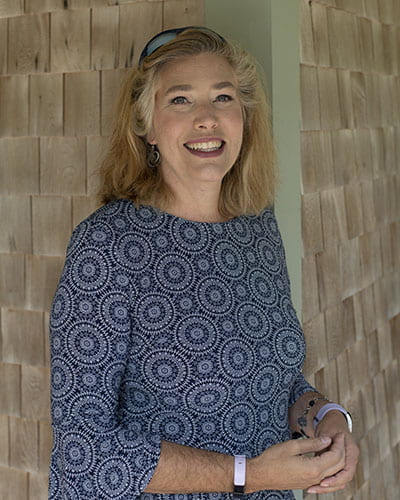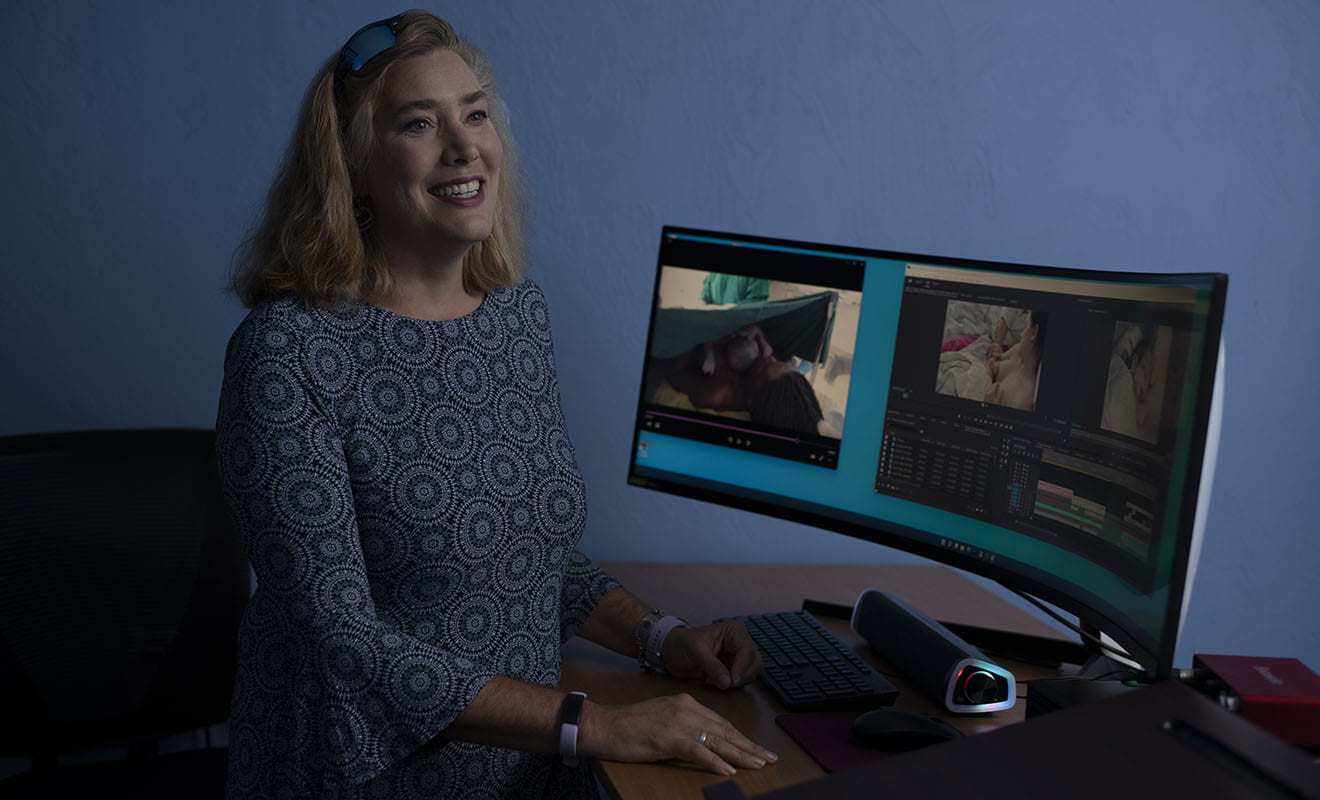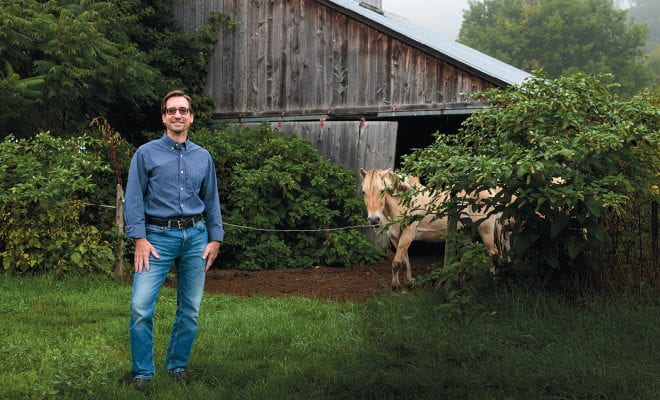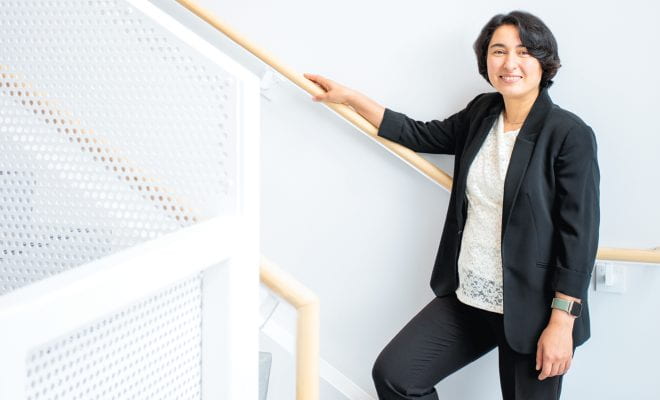Bringing attention to invisible work, the essential tasks that are frequently unacknowledged, is one of Brimdyr’s specialties. She believes video ethnography—the recording of subjects in their current setting for research purposes—is an excellent tool to help people understand an activity’s complexities that might otherwise go unnoticed. With the knowledge that a baby’s instinctive journey during this sensitive time after birth leads to the best outcomes if it is allowed to happen, getting that word out became her passion.
Some people are lucky enough to have a lightbulb moment in their lives that reveals a career path they are destined to take. But for many, the path is more like a hopscotch game—landing in one spot before they advance to the next.
For Kajsa Cadwell Brimdyr ’92, the path from a computer science major and devoted theatre enthusiast at WPI to an international expert on maternal child health and a lead ethnographic researcher for Healthy Children Project, Inc., was not direct. But each step, she says, led her to the next right spot.
Brimdyr, an expert on continuous and uninterrupted skin-to-skin contact in the first hour after birth, documents the essential but often invisible benefits of this magical hour using video ethnography. She advocates for letting the tiniest human beings do the work that is instinctive and beneficial for both baby and mom—but often not understood or prioritized in the wider healthcare system.

She witnessed the barriers herself. Looking around the busy labor and delivery room after delivering her first daughter, Brimdyr’s research brain knew how skin-to-skin contact supported the work of the baby. But as a new mom, she saw how the fast-paced period immediately following birth leaves little time for an unplanned request for an uninterrupted hour of skin-to-skin contact. And how choosing a supportive system can make all the difference.
If that hour is prioritized, the potential impact is extraordinary. “With nothing more than skin-to-skin contact in that first hour after birth, you can reduce the infant mortality rate by 22 percent,” she says. “The baby hears the mother’s heartbeat, is warmer, is colonized by the mother’s bacteria. Everything is more stable.”
A Pull to Math and Theatre
The roots of Brimdyr’s work began at WPI where she developed the research and presentation skills that she says formed the foundation of her career as an ethnographic researcher who uses video to explore the stories of invisible work.
As a high school student, she loved high-level mathematics and had her sights set on engineering. But she was also comfortable in the world of theatre, refining her artistic skills as a decade-long veteran of the esteemed multigenerational Harwich Junior Theatre on Cape Cod. While she was drawn to WPI because of its particular emphasis on technology and the challenges it offered, when she read about Susan Vick, the now-retired director of WPI’s drama and theatre programs, and saw the endless opportunities for theatre work on campus, she knew WPI was her place. “The idea that you could combine engineering with theatre was so exciting,” she recalls. “It brought together the things I was most fascinated by and that I loved. I look back now and say it all makes sense.”
For Brimdyr, being able to adroitly run the lights, stage a set, play a lead role, or write a play wasn’t far from working effectively on a math problem, she says. “It’s that connection to mathematics and to the idea of problem solving and challenges,” she says. “When I visited WPI, everything I heard was about teamwork and cooperation and overcoming challenges. That all really appealed to me.”
But without a direction, Brimdyr realizes she might not have ended up in a career she loves. “I was lucky enough to have Van A [Dean John van Alstyne, a former mathematics professor] as my advisor,” she says, and that changed everything. “He was a magical, magical man who saw who you were, saw your potential, and saw the opportunities. He was the one who steered me to computer science when I thought I was originally going to do electrical engineering.” Van A purposefully made time for students, Brimdyr says, and when she walked into his office, she felt seen and understood. “He knew you and was interested in you as a person,” she says. “There was something about his presence that enveloped you.”
I knew I needed to be part of a team that would change the world, but that’s not a path. To get from those feelings to something more concrete is tricky.
At the time, computer science was a burgeoning field, nearly tripping over itself with new
developments and advances. For someone who knew she wanted to change the world in some way, it was tough to get a grip on what that meant for a career. But Van A provided the direction Brimdyr needed. “I remember him always having time,” she says. “That’s really important when you feel like you aren’t sure what you’re doing or you know this is the right path but don’t know what to do with it. But for those of us who know they don’t have a straight path for their future, that can feel intimidating. I knew I needed to be part of a team that would change the world, but that’s not a path. To get from those feelings to something more concrete is tricky.”
Even as Brimdyr learned a new computer language or skill, she was fully aware that she would need to start over again shortly as knowledge evolved. “The thing I loved about computer science was that it was unknown,” she says. “The idea was you’re learning something knowing you’d have to innovate so you could continue to learn because the challenges were going to continue.” And she thrived in an environment that celebrated continually evolving projects and problems with no set final answer. She carefully watched those around her to figure out how she could have both the career and the life she wanted.
Former computer science professor Mary Hardell was one such role model. “She taught assembly–one of the hardest computer science classes there was,” she says. “And she was tough; she took no nonsense. I thought, ‘I want to be you, and I can be in this field.’” As a counterpoint, Brimdyr found a “gentle and sweet” demeanor in David Finkel, her computer science advisor. With the success of two such disparate people, Brimdyr had proof that she could be true to herself while following her heart.
Brimdyr’s Major Qualifying Project (MQP) allowed her to sharpen the skills that she uses to this day. Her team worked on their human-computer interaction project, and advisor Craig Wills, then a new professor at WPI, worked with them to get the innovative research published. Even after graduation, Brimdyr continued to present the work. With continual refinement of her presentation skills, she became comfortable with extensive research and with explaining its value to many audiences.
The flip side of her WPI work—theatre—was significant for her professional development. “The theatre people were all mine—that’s my group,” she says. Working under the direction of Vick, Brimdyr wrote, directed, and produced plays for Masque and New Voices and occasionally did sound and lighting for Lens and Lights.
“If the Harwich Junior Theatre was my foundation, WPI theatre elevated it,” she says. “The theatre we were doing was so fascinating because it was engineering theatre. We were doing the Scottish tragedy and we said, ‘What we really need to do is have a running river going through the middle of the stage. And when she plunges her hands into the river, it needs to turn red with blood and it needs to run through the audience with blood-red water,’” she says, laughing; red Jello and innovative engineering was the obvious solution.
An Unexpected Path
For Brimdyr, becoming a researcher in the maternal child health arena didn’t happen right away. After graduation, she took a job with Digital Equipment Corporation implementing management protocols, putting theory into practice with a team of expert programmers. “I loved every minute of it,” she says. While working for Digital, Brimdyr was presenting her MQP work at a conference when a chance conversation steered her toward Blekinge Institute of Technology in Sweden. She learned about the university’s newly developing human-computer interaction program. One thing led to another and “I quit Digital and moved to Sweden,” she says.

While working there, helping to develop a bachelor’s and a master’s degree in People, Computers, and Work, she earned her master’s degree in human computer interaction from Vermont College’s remote program and then her PhD from Union Institute & University. One of Brimdyr’s PhD courses was on ethnography, the study of how people work, and she found the direction she wanted. As she focused her dissertation on the invisible, unnoticed work of women, in particular the job of a front-desk receptionist, the pathway to changing the world with her work opened up.
The idea of invisible work stayed with Brimdyr even as she returned to the States to raise a family with her husband, Joshua Howard Brimdyr ’92. She continued to spend 10 weeks in Sweden every year to teach courses in human and computer interaction at Blekinge but also began to work with her mother on maternal/child healthcare. Her mother, a noted maternal/child healthcare expert, founded Healthy Children Project, Inc., where Brimdyr works now. “She understood the new research that said when babies are born, they should be skin-to-skin,” says Brimdyr, “so when I had my daughter in ’97 (Emma ’19), I knew that. I thought it was amazing and magical, but it was unusual for that time. And I looked around at all the people in that room doing important and invisible work, and I became fascinated by what was happening in the labor and delivery room.”
The fascination was twofold. The labor and delivery process was often predicted by evidence-based practice but also by set rules, time restrictions, and insurance regulations. Brimdyr wanted to know what barriers could prevent something as simple, evidence-based, and cost free as skin-to-skin contact in the first hour.
Advocating for Skin-to-Skin Contact
Brimdyr began working internationally with countries looking to reduce their infant mortality rates. With her video and ethnography background, Brimdyr connected with Ann-Marie Widström, PhD, nurse midwife, an international expert who first observed and documented the nine stages of a baby’s behavior after birth, and realized healthcare workers would need to actually see the baby’s work to understand why skin-to-skin was essential and not simply a nice-to-have snuggle with mom.
The power of watching a baby or reading about the experience is vastly different, she says. “Seeing it changes everything. You have to value the work the baby is doing. Once you see what they are doing, it is remarkable.”
Brimdyr began to use video ethnography with iterative design skills to get the word out about skin-to-skin contact with Skin to Skin in the First Hour After Birth, which informed and educated a healthcare audience showing how to promote skin-to-skin contact after a vaginal or cesarean birth in U.S. hospitals. She then created the Telly Award-winning documentary, The Magical Hour, a video for a parent audience. She worked with Tobey Hospital in Wareham, Mass., where she had experienced the best-practice, evidence-based skin-to-skin contact with her own births, to created the Happy Birth Day video series, available on Amazon.com, to illustrate normal birth and immediate skin-to-skin contact. Brimdyr also used video ethnography to conduct research, especially in Egypt and the U.S., publishing vital research papers in peer-reviewed journals documenting the stages of the newborn during the first hour after birth, and the impact of labor medications.
Currently, Brimdyr presents her skin-to-skin research for premature infants to organizations, governments (including a recent video ethnography project for the Ministry of Health for Uganda), and conferences worldwide, instructing the midwives, healthcare providers, speech language specialists, and other professionals in attendance of the benefits of skin-to-skin contact in the first hour after birth. She knows that showing a baby’s work in that time is going to help both healthcare staff and parents advocate to change the system, she says, because “parents can ask for this, but it’s the system that determines if it will happen.”
Overcoming Barriers
In each location, barriers pop up–from lack of time to not understanding the proven impacts of having a baby skin-to-skin in the first hour after birth, instead of being held wrapped or in an electric warmer. In the U.S., she finds systemic racism is one of the largest and most persistent barriers to implementing skin-to-skin contact in the first hour. In the Baby-Friendly Hospital Initiative (BFHI) launched by the World Health Organization and the United Nations Children’s Fund, skin-to-skin contact is part of the standards hospitals must implement. But in the U.S., many areas with predominantly Black residents do not have any Baby-Friendly hospitals near them. “So right there is a huge problem,” she says, noting that the rates of infant mortality for Black babies is higher than those of other populations.
In the U.S., parents are sometimes asked if they want skin-to-skin contact after birth, she says, but the question and the follow-up are too frequently sporadic. Even if parents say yes, the baby could have fleeting contact and not a full hour. And the way each provider presents the opportunity influences the result. When hospital staff told Brimdyr that patients weren’t interested in skin-to-skin time, she asked to follow a nurse into a room to hear what patients were saying.
My work is my passion. It’s everything I think about. I think about it at night, and I wake up excited. It is part of who I am.
“The nurse said, ‘After the baby is born, it’s bloody and sticky. Do you want us to give it to you that way or wipe it off and give it a bath first?’” Shocked, Brimdyr asked if she could take a turn with presenting the idea to the next patient. “I went in and said, ‘You are so lucky to have this opportunity in this hospital for skin-to-skin contact after birth. Your baby will hear your heartbeat and your face will be the very first your baby ever sees. Would you like to do that?’ And the mother said, ‘Yes’ and then the nurse said, ‘We can do that.’”
The fault lies squarely in one place. “It’s the system,” Brimdyr says, noting that she frequently reaches back to her WPI foundation and her problem-solving skills throughout her career. “Step one is to see the baby and to ensure that the baby’s work is not invisible,” she says. “This takes problem solving, teamwork, and using new technology all the time. And then the theatre comes in as I am always presenting—whether that’s to a crowd of 1,000 or a team of four at a nurses’ station.”
Gaining all those skills and using them while at WPI made an impact on Brimdyr’s life. “It all comes back to that question of ‘I want to change the world and I have no idea how I am going to do that,’” she says. “You can do that if you have the tools. You’re going to be jumping into new teams and you have to figure out how to make it work.”
As she did at WPI, Brimdyr embraces the challenges. “I’m the kind of person who is never going to retire,” she says, “and I’ve known that since I was tiny. My work is my passion. It’s everything I think about. I think about it at night, and I wake up excited. It is part of who I am. That first hour after birth is such a sensitive and amazing period. It makes me think everything is possible.”





